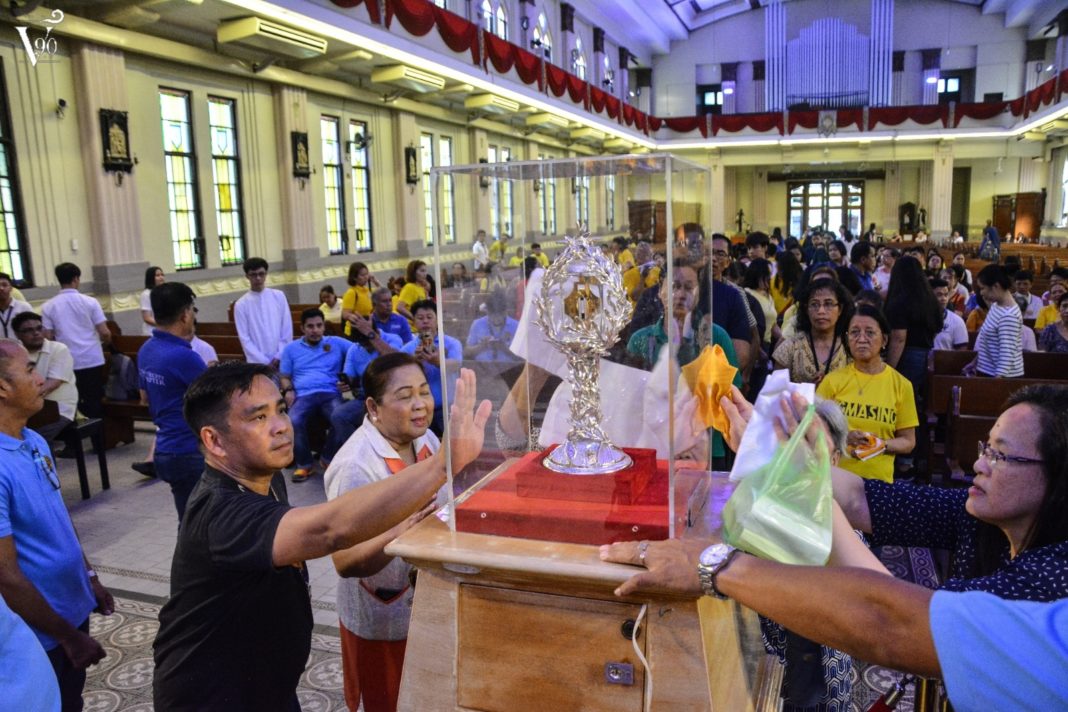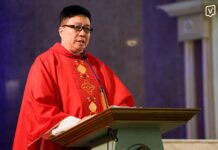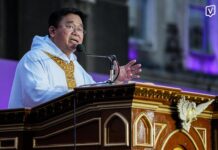THE UNIVERSITY welcomed the blood relic of St. John Paul II, the Pope who visited UST
twice first in 1981 and in 1995, on May 15.
Three-time UST rector Fr. Rolando de la Rosa, O.P., in his homily for the welcome Mass
for the late Pontiff’s relic, said the faithful should focus on living a good life instead of their
popularity.
Politicians and celebrities, he said, become “people of the past” but saints like John Paul
II will remain and continue to make Jesus Christ present in our lives.
“Show to others the unconditional love of God and feel how much God loves you,” he said in his homily. “We don’t just remember [Pope St. John Paul II], we bring him to our deepest pain, our request for healing. Our praises to God, we send through him.”
De la Rosa stressed that popularity transcends the legacy of the life of a saint.
“‘Yong mga politiko, lalo na ‘yong mga nanalo, they are very famous, although some
say they are notorious. ‘Yong mga pictures nila, nakapaskil sa mga poste. Nakakita na ba
kayo ng taong tumitingin sa mga pictures ng mga senador na ‘to o mga tumatakbong senador at kinakausap sila? Addressing them? Wala,” he said.
The Eucharist is not a God but it is the presence of Jesus Christ that the faithful celebrates, which St. John Paul II taught, he added.
Calling for the end of self-demotion, de la Rosa reminded the youth of St. John Paul II’s message that God loves them unconditionally.
“Nobody is perfect until he is loved. So, especially the young people who are here, you are loved unconditionally by God. Don’t [try] to value yourself in terms of the opinions of other people. Kung tinitingnan niyo sa ilan na ba ang likes niyo at kaunti lang, ang baba ng tingin niyo sa sarili niyo,” he said.
The blood relic stayed in the University until May 16. The visitation is part of the year-long
pilgrimage of the relic in celebration of the Year of the Youth. De la Rosa also described his
“resurrection experience” during the pope’s visit to UST in 1995.
“[Reurrection experience] is when you are able to tell yourself, ‘I am never the same again.’ Why? Because the presence of a saint brings a transforming grace,” de la Rosa, who was UST rector during the 1995 papal visit, said.
Throughout his pontificate, Pope St. John Paul II visited 129 countries. He visited the country twice — in 1981 and during the World Youth Day festivities in 1995.
In his first visit, the Varsitarian released a religious special issue that tackled how the Pope St. John Paul II beatified five Thomasians, as well as St. Lorenzo Ruiz and 11 missionaries who were martyred in Nagasaki, Japan in 1637.
The late pontiff is known as the “saint-maker,” as he beatified 1,388 faithful and canonized more than 470 saints at St. Peter’s Square.
The Varsitarian also released a 24-page special issue on Pope St. John Paul II’s return to the Philippines in 1995 for the World Youth Day.
In UST, John Paul II urged Filipinos put primacy on the ethical, the human person and one’s spirit above anything.
He also called on the Filipino youth to be self-disciplined and ready to change false values that had enslaved young people and adults.
St. John Paul II released the papal encyclical “Evangelium Vitae” or “The Gospel of Life,” which rejected threats to the dignity of life such as murder, abortion, euthanasia
and the death penalty.
In his exhortation Familiaris Consortio, St. John Paul II stressed that the divorced and remarried cannot receive communion since “their state and condition of life objectively contradict that union of love between Christ and the Church which is signified and effected by the Eucharist.”
Allowing them to receive the Eucharist would lead to error and confusion on the Church’s teaching on the indissolubility of marriage, he wrote.
On May 18, 1920, he was born Karol Józef Wojtyla in Wadowice, Poland.
When he was elected pope in 1978, he took the name John Paul II.
His episcopal motto was inspired by St. Louis de Montfort, “Totus Tuus – I am completely yours.”
On May 13, 1981, he survived an assassination attempt in St. Peter’s Square. Two years later, he visited and forgave his attacker, Ali Agca, in Rebibbia Prison.
Pope John Paul II died on April 2, 2005, due to Parkinson’s disease. He was canonized by Pope Francis on April 27, 2014. M. C. Serquina













